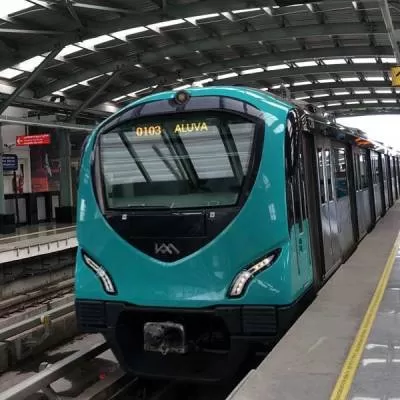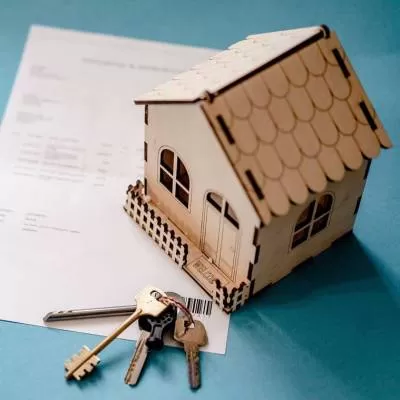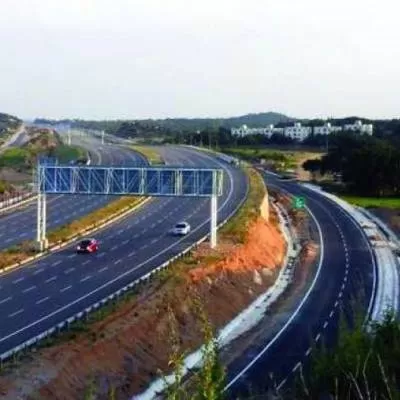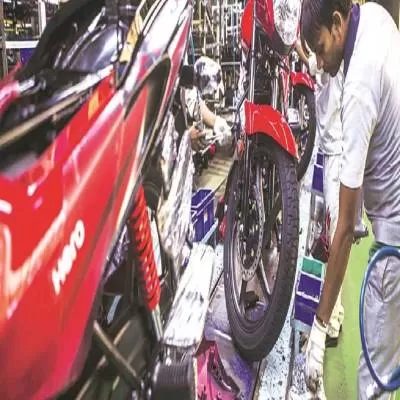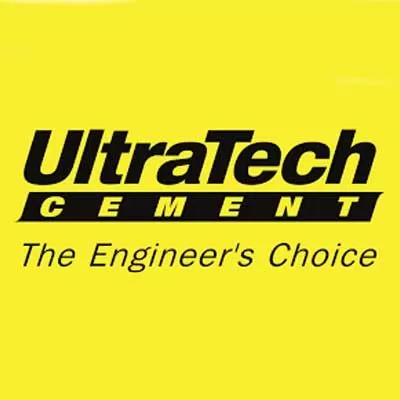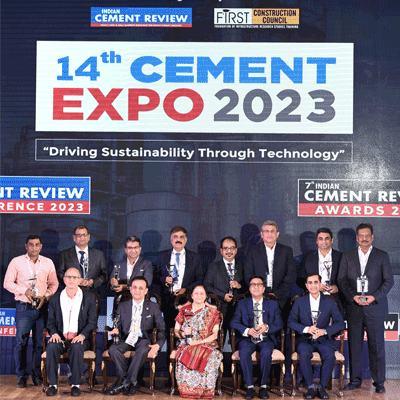- Home
- Building Material
- Cement
- ACC's La Residency
ACC's La Residency
It was a red-letter day for the country - on June 30, 2008, Prime Minister Dr Manmohan Singh released India's first 'National Action Plan on Climate Change'. While the plan outlined existing and future policies and programmes addressing climate mitigation and adaption, emphasis was also laid on the scarcity of water and power: the biggest challenge faced in India. In tune with this policy, ACC decided to redesign a building addressing these issues. The result is La Residency, a 45-year-old residential apartment block in Thane, Mumbai, now redesigned and converted as a state-of-the-art residential facility for the faculty and participants of the ACC Academy. Shriyal Sethumadhavan delves into the green-abilities of this building in conversation with Rakesh J Modi, Project Leader, Executive Assistant to CEO & MD, ACC Ltd...
Glory of the '60s: Architecture has always frozen time. As the building belonged to the 1960s, the architects decided to restore La Residency to its old glory. For this, the original materials used in the building were studied and documented. One of the challenges was to use terrazzo cement flooring, which was originally used in the building. Also, the old railing had to be restored, because of which, the sizes of the windows could not be altered. The old glory had its own charm and hidden benefits, which we decided to preserve.
Core idea: We have a long history of environment-friendly practices, not only in the manufacture of cement but also in its applications. Along with the national policy, we have been inspired by the cause of sustainable construction as promoted by the Holcim Foundation. Our promotion of green buildings, therefore, was a natural result of all these factors. The initial idea was to make a zero-energy building; the energy requirement of the building had to be reduced to a minimal level, and energy had to be generated by means of non-carbon technology, by wind and/or solar power. However, looking at the techno-commercial feasibility, the plan was rolled back and partly implemented. The ACC core team for this project also included Bharat Dalal; Arvind Patil, Worksphere (the main architects); and Clancy Global (green consultant).
Powering up: Initially, we wanted the entire building to work on solar power. However, the number of solar panels required for the building was large, and with the available space, it was impossible to incorporate so many panels. Nevertheless, we have provided the required 12 per cent of power generation through these panels to meet the IGBC norms. But, this was not sufficient for a zero-energy building. Hence, we decided to use wind energy. We have wind farms in Satara where energy is generated through wind mills. This energy is also wheeled to the MSEB grid lines; from there, it is supplied to us. So, basically it counts for zero power consumption. And, we are practically using wind as a natural resource for La Residency. We are also considering solar panels in all our corresponding concepts. Furthermore, HVAC, usually the biggest guzzler of power in any building, amounts to almost 65 per cent of the energy load. This has been reduced drastically. We have fitted LED lights to add to the efficiency in the system, and the building is occupied predominantly in the night. Hence, the overall mapping indicates that the building needs less power compared to any other conventional building.
Exchanging heat: In the 1960s, mechanical cooling was not prevalent and sunshades were used with ventilators below. It has been observed that as per the latitudinal and longitudinal location of our country, a 600 mm average chajja can completely shade a window that is above 900 mm. These chajjas, which have been a part of old buildings, act as sunshades and do not allow heat to penetrate through the windows. Observing the same for La Residency, the ventilators above the windows are kept open, ensuring a continuous movement of air throughout the day. The building incorporates a unique, high-efficiency ground heat exchanger system to provide cool or hot air, taking advantage of the fact that underground water is cooler than that on the earth's surface, thus acting as a ground earth-based heat exchange system. It is not only the uniqueness of the technology but the context in which this system is used. Further, the architects in the '60s had designed the building in a way that protected it from excess heat. 'Y' was the exact shape of the building; this Y-shape geometry causes natural shading on each plane, which reduces heat intake. This construction detailing juxtaposed with an efficient HVAC system has resulted in an eco-friendly building. In addition, the campus uses bore-water/well water for gardening and flushing. The temperature of this water being 27°C around the year is also used by the heat exchanger. This has resulted in energy saving by 10 per cent. Moreover, the construction details are based on thermal simulation and have helped reduce the air-conditioning requirement drastically.
Materialising green: Instead of aping the west and using glass, the facades and materials have been designed in response to the tropical climate of our country. This has reduced the energy demand of the building as well as power consumption without having to spend excessive capital. Also, in La Residency, the dual flush system for toilets, double-glazed windows, solar water heater, ground heat exchange AC system, etc, have contributed in saving water and energy to a great extent. 'Restore-recycle-reuse' is the basic philosophy for green. This means that the building while under construction, in use and during demolition should cause minimum harm to the environment. Therefore, the materials selected for La Residency were based on certain criteria. For instance, the manufacturing unit is within a 600 km radius from the site, making the transportation of materials like tiles, laminated wooden flooring and gypsum boards more environment-friendly. Also, the materials used, like gypsum boards, doors and frames, are made of recycled content (salvaged material). Moreover, to ensure that the materials are biodegradable or recyclable, we have used aluminium louvres, copper pipes, etc, so that when the building is broken down, it will minimally harm the environment. And finally, materials like UPVC windows and china mosaic have been used to improve the performance of the building while reducing the energy demand. China mosaic, a material with high reflective index, has also been used on the roof to reflect sunlight, thereby preventing the absorption of heat.
Every drop counts: The use of potable water at La Residency is reduced by selecting low-flow fixtures and reusing grey water. Rainwater is harvested by channelling roof water precipitation into an open well at site. The push taps in the basins trap air and create froth, reducing the amount of water, yet giving the user the sense of a large amount of water. Also, dual flushes have been used for toilets. The wastewater from the toilets and sink is treated and used for landscape. The landscape is serviced using drip technology, which saves water. Further, the soil has been given a gradient, which allows water to flow over it, thereby watering more plants.
Creating a benchmark: We are singularly satisfied with our achievements in the realm of green buildings. La Residency is a pre-construction, Platinum-rated LEED project. It is expected to be the first and only project in India to achieve the distinction of being rated Platinum in two categories: Green Homes and New Construction & Major Renovation. We believe that we may have set a trend in this genre, as La Residency is likely to be a benchmark for converting and renovating old residential structures into green, energy-efficient buildings.
Project details:
Developer: ACC Ltd. Tel: 022-3302 4321. Fax: 022-6631 7440. Website: www.acclimited.com
Contractor and civil finish: Ashraay Enterprises; Anil Electricals. Tel: 0141-236 0477. Fax: 0141-510 8156. E-mail: sales@anilelectricals.in Website: www.anilelectricals.in; Nikhil Comforts. Tel: 022-2568 7048.
Architect/planner: Worksphere Architects. Tel: 022-6726 0100. Fax: 022-256 6714. E-mail: bd@workspherearchitects.com Website: www.workspherearchitects.com
Landscape architect: SGC designs. Tel: 022-2610 5029. E-mail: sgcdesign@yahoo.co.in
Website: www.sgcdesigngroup.com
Green and services consultant: Clancy Global. Tel: 022-2568 4776. E-mail: enquiries@clancy-global.com Website: www.clancy-global.com
External cladding consultant: Worksphere Architects.
External cladding contractor: Ruby Enterprise
HVAC contractor: Nikhil Comforts. Tel: 022-2568 7048;
Wipro Energy Systems. Tel: 080-4199 4000. Fax: 080-4199 4010. E-mail: sales.ecoenergy@wipro.com Website: www.wiproecoenergy.com
Lights: Bhavani Lights. Tel: 022-2471 1073.
Electrical and fire-detection systems: Vijay Trastech Pvt Ltd. Tel: 022 -2847 8782. Fax: 022-2847 8514. Website: www.vijaytranstech.com
External cladding: Ruby Enterprise
Roofing, paints, cement: Ashraay Enterprises
Glazing: Aquaplast India. Tel: 0484-270 5874. Fax: 0484-270 5873. E-mail: aquaplastmumbai@yahoo.com; Rusabh Aluminium. Tel: 022- 2242 5206.
Flooring /tiles: Bharat Flooring. Tel: 022-4057 4444. Fax: 022- 4057 4406. E-mail: info@bharatfloorings.com. Website: www.bharatfloorings.com
Painting contractor: Technics Unlimited. Tel: 022-6163 1781. Website: www.technicsunlimited.in
RJ Modi's perspective
"More than business sense, green makes moral sense. It may make business sense to a manufacturer. But, in business, very few think about moral sense and there is a need to think beyond business. Every individual should understand that sustainability for us is different compared to the US or other developed nations. We can ill-afford to bring energy demand down in sectors like manufacturing, IT, and so on. Our carbon footprint is much lower compared to others, and we are definitely a growing nation. What sustainability means to us is adequate potable water and sumptuous food to our villages, where children die owing to malnutrition and basic sanitation facilities. Power in villages too is a secondary need. Hence, being responsive to water and food should be our outlook towards sustainability. Ideally, all our actions should conserve and produce these."
Would you like to share details of any green initiatives? Write in to us at feedback@ASAPPmedia.com
Welcome to the first project in India that aims to achieve the distinction of being rated Platinum in two categories: Green Homes and New Construction & Major Renovation.It was a red-letter day for the country - on June 30, 2008, Prime Minister Dr Manmohan Singh released India's first 'National Action Plan on Climate Change'. While the plan outlined existing and future policies and programmes addressing climate mitigation and adaption, emphasis was also laid on the scarcity of water and power: the biggest challenge faced in India. In tune with this policy, ACC decided to redesign a building addressing these issues. The result is La Residency, a 45-year-old residential apartment block in Thane, Mumbai, now redesigned and converted as a state-of-the-art residential facility for the faculty and participants of the ACC Academy. Shriyal Sethumadhavan delves into the green-abilities of this building in conversation with Rakesh J Modi, Project Leader, Executive Assistant to CEO & MD, ACC Ltd...Glory of the '60s: Architecture has always frozen time. As the building belonged to the 1960s, the architects decided to restore La Residency to its old glory. For this, the original materials used in the building were studied and documented. One of the challenges was to use terrazzo cement flooring, which was originally used in the building. Also, the old railing had to be restored, because of which, the sizes of the windows could not be altered. The old glory had its own charm and hidden benefits, which we decided to preserve.Core idea: We have a long history of environment-friendly practices, not only in the manufacture of cement but also in its applications. Along with the national policy, we have been inspired by the cause of sustainable construction as promoted by the Holcim Foundation. Our promotion of green buildings, therefore, was a natural result of all these factors. The initial idea was to make a zero-energy building; the energy requirement of the building had to be reduced to a minimal level, and energy had to be generated by means of non-carbon technology, by wind and/or solar power. However, looking at the techno-commercial feasibility, the plan was rolled back and partly implemented. The ACC core team for this project also included Bharat Dalal; Arvind Patil, Worksphere (the main architects); and Clancy Global (green consultant).Powering up: Initially, we wanted the entire building to work on solar power. However, the number of solar panels required for the building was large, and with the available space, it was impossible to incorporate so many panels. Nevertheless, we have provided the required 12 per cent of power generation through these panels to meet the IGBC norms. But, this was not sufficient for a zero-energy building. Hence, we decided to use wind energy. We have wind farms in Satara where energy is generated through wind mills. This energy is also wheeled to the MSEB grid lines; from there, it is supplied to us. So, basically it counts for zero power consumption. And, we are practically using wind as a natural resource for La Residency. We are also considering solar panels in all our corresponding concepts. Furthermore, HVAC, usually the biggest guzzler of power in any building, amounts to almost 65 per cent of the energy load. This has been reduced drastically. We have fitted LED lights to add to the efficiency in the system, and the building is occupied predominantly in the night. Hence, the overall mapping indicates that the building needs less power compared to any other conventional building.Exchanging heat: In the 1960s, mechanical cooling was not prevalent and sunshades were used with ventilators below. It has been observed that as per the latitudinal and longitudinal location of our country, a 600 mm average chajja can completely shade a window that is above 900 mm. These chajjas, which have been a part of old buildings, act as sunshades and do not allow heat to penetrate through the windows. Observing the same for La Residency, the ventilators above the windows are kept open, ensuring a continuous movement of air throughout the day. The building incorporates a unique, high-efficiency ground heat exchanger system to provide cool or hot air, taking advantage of the fact that underground water is cooler than that on the earth's surface, thus acting as a ground earth-based heat exchange system. It is not only the uniqueness of the technology but the context in which this system is used. Further, the architects in the '60s had designed the building in a way that protected it from excess heat. 'Y' was the exact shape of the building; this Y-shape geometry causes natural shading on each plane, which reduces heat intake. This construction detailing juxtaposed with an efficient HVAC system has resulted in an eco-friendly building. In addition, the campus uses bore-water/well water for gardening and flushing. The temperature of this water being 27°C around the year is also used by the heat exchanger. This has resulted in energy saving by 10 per cent. Moreover, the construction details are based on thermal simulation and have helped reduce the air-conditioning requirement drastically.Materialising green: Instead of aping the west and using glass, the facades and materials have been designed in response to the tropical climate of our country. This has reduced the energy demand of the building as well as power consumption without having to spend excessive capital. Also, in La Residency, the dual flush system for toilets, double-glazed windows, solar water heater, ground heat exchange AC system, etc, have contributed in saving water and energy to a great extent. 'Restore-recycle-reuse' is the basic philosophy for green. This means that the building while under construction, in use and during demolition should cause minimum harm to the environment. Therefore, the materials selected for La Residency were based on certain criteria. For instance, the manufacturing unit is within a 600 km radius from the site, making the transportation of materials like tiles, laminated wooden flooring and gypsum boards more environment-friendly. Also, the materials used, like gypsum boards, doors and frames, are made of recycled content (salvaged material). Moreover, to ensure that the materials are biodegradable or recyclable, we have used aluminium louvres, copper pipes, etc, so that when the building is broken down, it will minimally harm the environment. And finally, materials like UPVC windows and china mosaic have been used to improve the performance of the building while reducing the energy demand. China mosaic, a material with high reflective index, has also been used on the roof to reflect sunlight, thereby preventing the absorption of heat.Every drop counts: The use of potable water at La Residency is reduced by selecting low-flow fixtures and reusing grey water. Rainwater is harvested by channelling roof water precipitation into an open well at site. The push taps in the basins trap air and create froth, reducing the amount of water, yet giving the user the sense of a large amount of water. Also, dual flushes have been used for toilets. The wastewater from the toilets and sink is treated and used for landscape. The landscape is serviced using drip technology, which saves water. Further, the soil has been given a gradient, which allows water to flow over it, thereby watering more plants.Creating a benchmark: We are singularly satisfied with our achievements in the realm of green buildings. La Residency is a pre-construction, Platinum-rated LEED project. It is expected to be the first and only project in India to achieve the distinction of being rated Platinum in two categories: Green Homes and New Construction & Major Renovation. We believe that we may have set a trend in this genre, as La Residency is likely to be a benchmark for converting and renovating old residential structures into green, energy-efficient buildings.Project details:Developer: ACC Ltd. Tel: 022-3302 4321. Fax: 022-6631 7440. Website: www.acclimited.com Contractor and civil finish: Ashraay Enterprises; Anil Electricals. Tel: 0141-236 0477. Fax: 0141-510 8156. E-mail: sales@anilelectricals.in Website: www.anilelectricals.in; Nikhil Comforts. Tel: 022-2568 7048.Architect/planner: Worksphere Architects. Tel: 022-6726 0100. Fax: 022-256 6714. E-mail: bd@workspherearchitects.com Website: www.workspherearchitects.comLandscape architect: SGC designs. Tel: 022-2610 5029. E-mail: sgcdesign@yahoo.co.in Website: www.sgcdesigngroup.comGreen and services consultant: Clancy Global. Tel: 022-2568 4776. E-mail: enquiries@clancy-global.com Website: www.clancy-global.comExternal cladding consultant: Worksphere Architects.External cladding contractor: Ruby EnterpriseHVAC contractor: Nikhil Comforts. Tel: 022-2568 7048;Wipro Energy Systems. Tel: 080-4199 4000. Fax: 080-4199 4010. E-mail: sales.ecoenergy@wipro.com Website: www.wiproecoenergy.comLights: Bhavani Lights. Tel: 022-2471 1073.Electrical and fire-detection systems: Vijay Trastech Pvt Ltd. Tel: 022 -2847 8782. Fax: 022-2847 8514. Website: www.vijaytranstech.comExternal cladding: Ruby EnterpriseRoofing, paints, cement: Ashraay EnterprisesGlazing: Aquaplast India. Tel: 0484-270 5874. Fax: 0484-270 5873. E-mail: aquaplastmumbai@yahoo.com; Rusabh Aluminium. Tel: 022- 2242 5206.Flooring /tiles: Bharat Flooring. Tel: 022-4057 4444. Fax: 022- 4057 4406. E-mail: info@bharatfloorings.com. Website: www.bharatfloorings.comPainting contractor: Technics Unlimited. Tel: 022-6163 1781. Website: www.technicsunlimited.inRJ Modi's perspectiveMore than business sense, green makes moral sense. It may make business sense to a manufacturer. But, in business, very few think about moral sense and there is a need to think beyond business. Every individual should understand that sustainability for us is different compared to the US or other developed nations. We can ill-afford to bring energy demand down in sectors like manufacturing, IT, and so on. Our carbon footprint is much lower compared to others, and we are definitely a growing nation. What sustainability means to us is adequate potable water and sumptuous food to our villages, where children die owing to malnutrition and basic sanitation facilities. Power in villages too is a secondary need. Hence, being responsive to water and food should be our outlook towards sustainability. Ideally, all our actions should conserve and produce these.Would you like to share details of any green initiatives? Write in to us at feedback@ASAPPmedia.com


